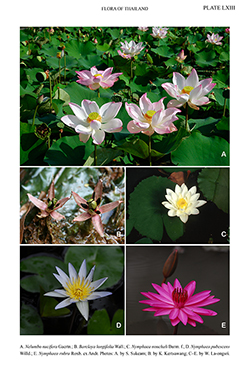e-Flora of Thailand
Volume 14 > Part 4 > Year 2020 > Page 540 > Nelumbonaceae > Nelumbo
Nelumbo nucifera Gaertn.wfo-0000382378
Fruct, 1: 73, t 19, f 2. 1788; Gamble, Fl. Pres. Madras 1: 34. 1915 (Repr.ed. 1: 24. 1957); Subramanyam, Aqua. Angio: 8, 1962; Royen, Nova Guinea 8. ser. 5: 105. 1962; Backer & Bakh.f., Fl. Java 1: 147. 1963; Mitra in Nayar et al., Fasc. Fl. India, 20: 8, 1990 & in Shama et al., Fl. India 1: 441, 1993; Dassanayake, Revis. Handb. Fl. Ceylon 5: 286. 1996. Fig. 1. Plate LXIII: A.
Accepted Name : This is currently accepted.
Synonyms & Citations :
Description : Leaves suborbicular, lamina 10–100 cm. in diam., dark green to bluish green above, paler beneath, margin entire, slightly undulate. Flowers 8–25 cm in diam., white to rose-pink, fragrant; peduncles up to 2 m long, with scattered stiff papillae. Sepaloid tepals 2–5 or more, ovate or elliptic, 1.5–5 by 0.8–3.5 cm, concave, green to pinkish green. Petaloid tepals ca 10–20, elliptic, concave, 4–15 by 2–8 cm, gradually becoming obovate to spathulate, apex obtuse or sub-acute. Stamens up to 225, 2.2–4.5 cm long, in certain cultivars modified to petaloid staminodes; filaments 7–25 mm long, linear to ovate or obovate; anther linear, 15–20 mm long, yellow, with 4 pollen-sacs; connective with 4–8 mm long, white to yellow-white appendage; receptacle 2–4 cm in diam., spongy, yellow during anthesis, turning first green and finally dark brown at fruit maturity. Ovary 12–30, embedded in flattened surface of enlarged obconical receptacle; style very short or lacking; stigma papillate, yellow, ca 1 mm in diam. Fruitlets oblong to ovoid, 1.5–2 by 1–1.5 cm, glabrous.
Thailand : NORTHERN: Chiang Mai, Chiang Rai, Phayao (Kwan Phayao), Nan Lamphun, Lampang, Nakhon Sawan (Bueng Borapet); NORTH-EASTERN: Nong Khai (Bueng Khong Long WS), Sakon Nakhon (Nong Han), Khon Kaen; EASTERN: Buri Ram (Huai Talat Reservoir Non-hunting area, Huai Chorakhaemak Reservoir WS); SOUTH-WESTERN: Prachuap Khiri Khan (Khao Sam Roi Yot NP); CENTRAL: Chai Nat, Suphan Buri, Pathum Thani; SOUTH-EASTREN: Rayong; PENINSULAR: Phatthalung (Tha Lae Noi Non-hunting area), Narathiwat (Klai Ban reservoir, Phi Kun Thong).
Distribution : India (type), N Australia, S & E Asia to Russia in the north.
Ecology : Freshwater plant in streams, ponds, river and rice paddies, from sea level to 500 m alt. Flowering and Fruiting: late May to middle of September.
Vernacular : Bua luang (บัวหลวง), phatum (ปทุม), buntharik (บุณฑริก), bua laem daeng (บัวแหลมแดง), bua laem khao (บัวแหลมขาว), satta bongkot (สัตตบงกช), satta but (สัตตบุษย์).
Uses: As ornamental plant, used for religious and decorative purpose. Seeds edible and sold in markets for medicinal purposes.
Notes: Nelumbo nucifera varying in flower-color as well as the relative number between petaloid tepals and petaloid staminodes. Flower size, flowering season, plant-height and leaf-size vary depending on the growing conditions. Flower colour is a stable character trait in individual plants. Flowers with less than 25 petaloid tepals are usually called single-flowered and those with over 50 petaloid tepals included petaloid staminodes are called double-flowered. Those in between with 25–50 petaloid tepals included petaloid staminodes are called intermediate.
Native Nelumbo nucifera only single-flowered. The double-flowered cultivars were probably introduced by traders or refugees from India or Java for using in ceremonies. Thus double flowered N. nucifera are mostly found in wetlands near urban centers and rarely occurs in rural areas.


